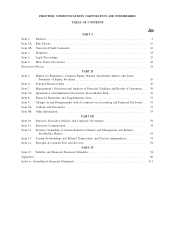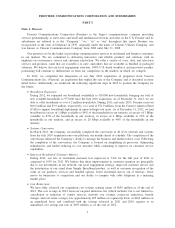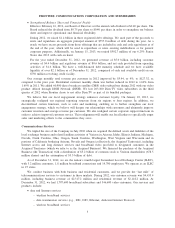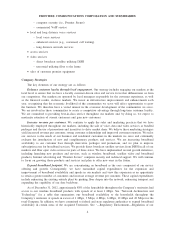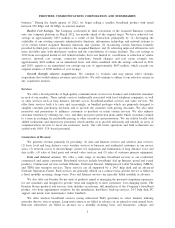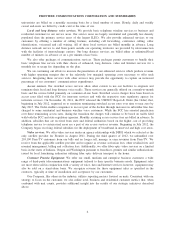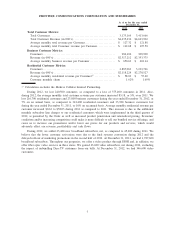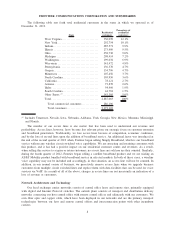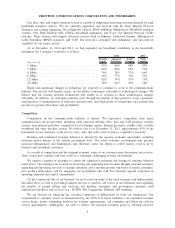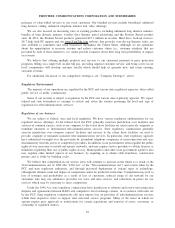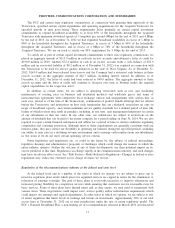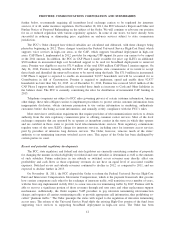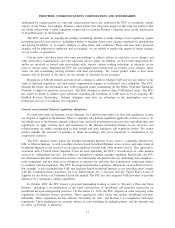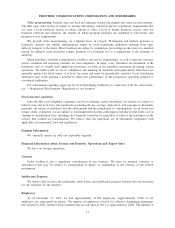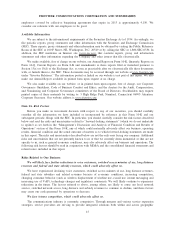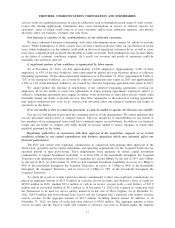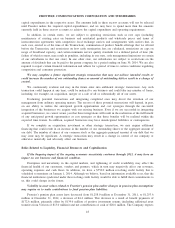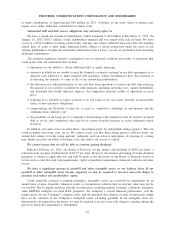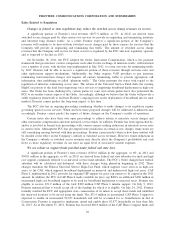Frontier Communications 2012 Annual Report Download - page 12
Download and view the complete annual report
Please find page 12 of the 2012 Frontier Communications annual report below. You can navigate through the pages in the report by either clicking on the pages listed below, or by using the keyword search tool below to find specific information within the annual report.The FCC and certain state regulatory commissions, in connection with granting their approvals of the
Transaction, specified certain capital expenditure and operating requirements for the Acquired Territories for
specified periods of time post-closing. These requirements focus primarily on certain capital investment
commitments to expand broadband availability to at least 85% of the households throughout the Acquired
Territories with minimum download speeds of 3 megabits per second (Mbps) by the end of 2013 and 4 Mbps
by the end of 2015. As of December 31, 2012 we had expanded broadband availability in excess of 1 Mbps to
86% of the households throughout the Acquired Territories, in excess of 3 Mbps to 84% of the households
throughout the Acquired Territories, and in excess of 4 Mbps to 78% of the households throughout the
Acquired Territories. We are on track to satisfy our 85% requirement for 3 Mbps by the end of 2013.
To satisfy all or part of certain capital investment commitments to three state regulatory commissions, we
placed an aggregate amount of $115.0 million in cash into escrow accounts and obtained a letter of credit for
$190.0 million in 2010. Another $72.4 million of cash in an escrow account (with a cash balance of $23.9
million and an associated liability of $0.2 million as of December 31, 2012) was acquired in connection with
the Transaction to be used for service quality initiatives in the state of West Virginia. As of December 31,
2012, $145.0 million had been released from escrow and the Company had a restricted cash balance in these
escrow accounts in the aggregate amount of $42.7 million, including interest earned. In addition, as of
December 31, 2012, the letter of credit had been reduced to $40.0 million. The aggregate amount of these
escrow accounts and the letter of credit will continue to decrease over time as Frontier makes the required
capital expenditures in the respective states.
In addition, in certain states, we are subject to operating restrictions such as rate caps (including
maintenance of existing rates on business and residential products and wholesale prices and terms of
interconnection agreements with competitive local exchange carriers and arrangements with carriers that, in
each case, existed as of the time of the Transaction), continuation of product bundle offerings that we offered
before the Transaction, and restrictions on how early termination fees are calculated, restrictions on caps on
usage of broadband capacity, and certain minimum service quality standards for a defined period of time (the
failure of which to meet may result in penalties, including, in one state, cash management limitations on certain
of our subsidiaries in that one state). In one other state, our subsidiaries are subject to restrictions on the
amount of dividends that can be paid to the parent company for a period ending on June 30, 2014. We are also
required to report certain financial information and adhere for a period of time to certain conditions regulating
competition and consumer protection. Although most of these requirements are generally consistent with our
business plans, they may restrict our flexibility in operating our business during the specified periods, including
our ability to raise rates in a declining revenue environment and to manage cash transfers from our subsidiaries
in two states if we do not meet certain operating service criteria.
Some legislation and regulations are, or could in the future be, the subject of judicial proceedings,
legislative hearings and administrative proposals or challenges which could change the manner in which the
entire industry operates. Neither the outcome of any of these developments, nor their potential impact on us,
can be predicted at this time. Regulation can change rapidly in the communications industry, and such changes
may have an adverse effect on us. See “Risk Factors—Risks Related to Regulation—Changes in federal or state
regulations may reduce the switched access charge revenues we receive.”
Regulation of the telecommunications industry at the federal and state level
At the federal level and in a number of the states in which we operate, we are subject to price cap or
incentive regulation plans under which prices for regulated services are capped in return for the elimination or
relaxation of earnings oversight. The goal of these plans is to provide incentives to improve efficiencies and
increased pricing flexibility for competitive services while ensuring that customers receive reasonable rates for
basic services. Some of these plans have limited terms and, as they expire, we may need to renegotiate with
various states. These negotiations could impact rates, service quality and/or infrastructure requirements which
could impact our earnings and capital expenditures. In other states in which we operate, we are subject to rate
of return regulation that limits levels of earnings and returns on investments. Approximately 26% of our total
access lines at December 31, 2012 are in state jurisdictions under the rate of return regulatory model. The
FCC’s National Broadband Plan, a non-binding set of recommendations released in March 2010 and described
11
FRONTIER COMMUNICATIONS CORPORATION AND SUBSIDIARIES


